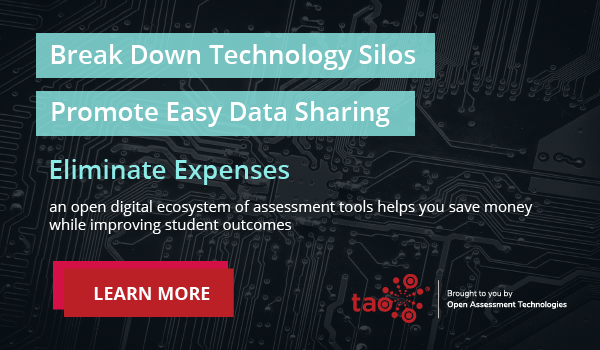Technology and digital learning have revolutionized how teachers can assess and teach students. While traditional methods of assessment typically have relied on rote memorization and answering multiple choice or true/false questions, newer, alternative assessments provide another option for educators.
Alternative assessments put the focus on 21st-century skills development and ask students to solve complex problems, in context, using learning from the unit. This approach to testing is designed to more authentically assess what students can do and how they can apply their knowledge and problem-solving skills to real-world scenarios. These assessments typically give a more accurate picture of learning and allow students to see and interact with material multiple times and in multiple ways, providing different avenues to show learning.
Not only do alternative types of assessments show teachers what their students can do, but they can also be more equitable than traditional testing. This is because much of the bias can be removed as students are free to demonstrate learning in different ways.
This post provides a breakdown of what alternative assessments may look like, and how to implement them in the classroom.
What is Alternative Assessment?
Alternative assessments are measures of learning that do not conform to traditional testing styles such as multiple choice, true/false, matching, essays, or short answer questions. Rather, educators focus more on higher-order thinking skills and growth towards a standard rather than the student’s ability to regurgitate facts on command. Within alternative assessments, there are a few major categories to consider:
Authentic Assessment
When educators ask students to apply what they learn from a unit or lesson to a relatable, contextual assignment, they are effectively participating in authentic assessment. Students can show not only their ability to memorize facts and figures, but also apply them to scenarios outside of the classroom. With authentic assessments, students can also demonstrate creativity and have the freedom needed to solve a problem using a unique approach.
Some examples of authentic assessment include:
- Case studies
- Scenarios/Hypotheticals
- Problem-based learning
Portfolio Assessment
Student portfolios are a great way to look at the big picture when considering what students can do. One of the difficulties that come with traditional testing is that there is a high-stakes nature where students have only one shot to show learning. However, this is not always reflective of how the real world works; in many cases, students and professionals are typically judged on a body of evidence. By having students create a portfolio of items that they believe show their learning the best and reflecting on those items, teachers can improve metacognition within their students and empower students to lead their learning.
Portfolio-based assessment is easiest to implement and most effective in classes where traditional assessment poses a challenge, such as with the arts, music, and creative writing. However, teachers of all contents can use portfolio assessments, it just may take a bit of creativity. For example, in Science class, students could make a portfolio of experiments, or in History, a portfolio of concepts or ideas based on learning in class. The key benefit of portfolios is that they look at an entire body of evidence, not just a single data point.
Performance-Based Assessment
Performance-based assessment is similar to authentic assessment in that students are asked to perform a real-world task or solve a real-world problem. The key with performance-based assessment is that it needs to assess the student in a novel situation where they can use what they have learned to be successful.
This can look different depending on the content and lessons, here are a few examples:
- Debates – students must argue a point or defend their thinking on the fly, and without a known set of questions coming from the opposing side.
- Competitions – for physical education students, competing or playing a sport requires students to demonstrate all aspects of a game, rather than testing skills in isolation.
- Problem-based learning – by asking students to solve unanswered questions or real-world problems they will need to use many different skills in their search for an answer or solution.
The key to performance-based assessments is that students need to draw on a variety of skills and abilities to be successful. In this way you can gauge not just what they know, but how they can use what they know in the real world.
Tips for Building Alternative Assessments
Building an alternative assessment may seem daunting at first, there can be a lot of components and it is a shift in thinking for many teachers. However, by following the tips below you can develop effective alternative assessments easily and effectively.
- Create a road map – by looking at the standards that you want to teach and developing objectives to reach these standards you can create a road map that keeps you on track and focused on the ending goal for the assessment.
- Plan the final product – before teaching any lessons, think about how students will show their learning in the end. Doing this ensures that learning tasks contribute to the final product and that your students will have what they need to be successful.
- Think about grading – with alternative assessments there is typically no set grading scale or rubric, teachers must determine what they few as successful and set criteria base on that.
- Stay open to possibilities – students will always surprise us, and that is a given. Alternative assessments can yield a wide range of student work, as a teacher, it is important to stay open to a large range of possible student responses to encourage creativity and thoughtfulness.
Using TAO to Create and Deliver Alternative Assessments
With advancements in testing platforms like TAO, teachers and schools can implement any type of digital assessment with less hassle and empower educators to act on data based on student performance. TAO also has the capability of leveraging granular metadata when reporting so that teachers can look at student progress aligned to assessment items or learning standards. This flexibility gives teachers the ability to further individualize testing and growth.
In addition to pulling and manipulating large sets of student data, TAO’s end-to-end product suite also has solutions to manage all aspects of the assessment process, such as grading with TAO Grader. TAO Grader is a program that allows educators to create rubrics for open-ended questions, which gives students more accurate feedback and provides teachers with an easy-to-use rubric that can be used in pulling data and targeting areas of growth. To learn more about how TAO can positively impact student achievement at your school, click here.

